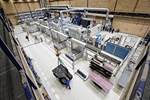General Dynamics Mission Systems delivers 1,000th F-35 nose radome
Marion, Virginia, team have designed, produced and tested more than 65,000 radomes for more than 50 aircraft, including the mission-critical F-35 radome.
On July 9, the General Dynamics Mission Systems Airborne Composites & Structures (Marion, Va., U.S.) team recognized the delivery of the 1.000th F-35 nose radome. The radomes are installed on airplanes belonging to the U.S Marines, U.S. Navy, U.S. Air Force and a growing list of foreign military partners (read “Skinning the F-35 fighter,” and “Fighter jet development and the "need" for the F-35”).
The radome is a critical component that enables the F-35 mission as a survivable and connected aircraft for global security in the 21st century. These radomes protect the airplane’s radar antennas while also enhancing its navigation and communications capabilities.
“Our team is proud of the advanced design, manufacturing capability and high-quality products built in Marion, Virginia. These radomes enable our nation’s and our allies’ aviators to achieve extraordinary levels of mission success,” says Laura Hooks, vice president and general manager at General Dynamics Mission Systems.
For the past 75 years, General Dynamics Mission Systems employees based in Marion have designed, produced and tested more than 65,000 radomes for more than 50 aircraft.
General Dynamics Mission Systems, a business unit of General Dynamics, provides mission-critical solutions to the challenges facing defense, intelligence and cybersecurity customers across all domains.
Related Content
-
TenCate Advanced Armour renamed to Integris Composites
With its rebranding, Integris maintains the ability to develop, test and manufacture ballistic armor and survivability solutions while expanding into new markets where composite solutions can be advantageous.
-
Orbital Composites wins AFWERX award for Starfighter drone fleet
Under the TACFI contract, Orbital is implementing the AMCM process to build 3D printed composite multi-mission UAS aircraft, surpassing $10 million in government awards.
-
US Air Force selects Integris Composites ballistic body armor
Cratus Wave armor is thin, lightweight and reduces heat stress, providing buoyant personal protection for the 582nd Helicopter Group.

















.jpg;maxWidth=300;quality=90)
